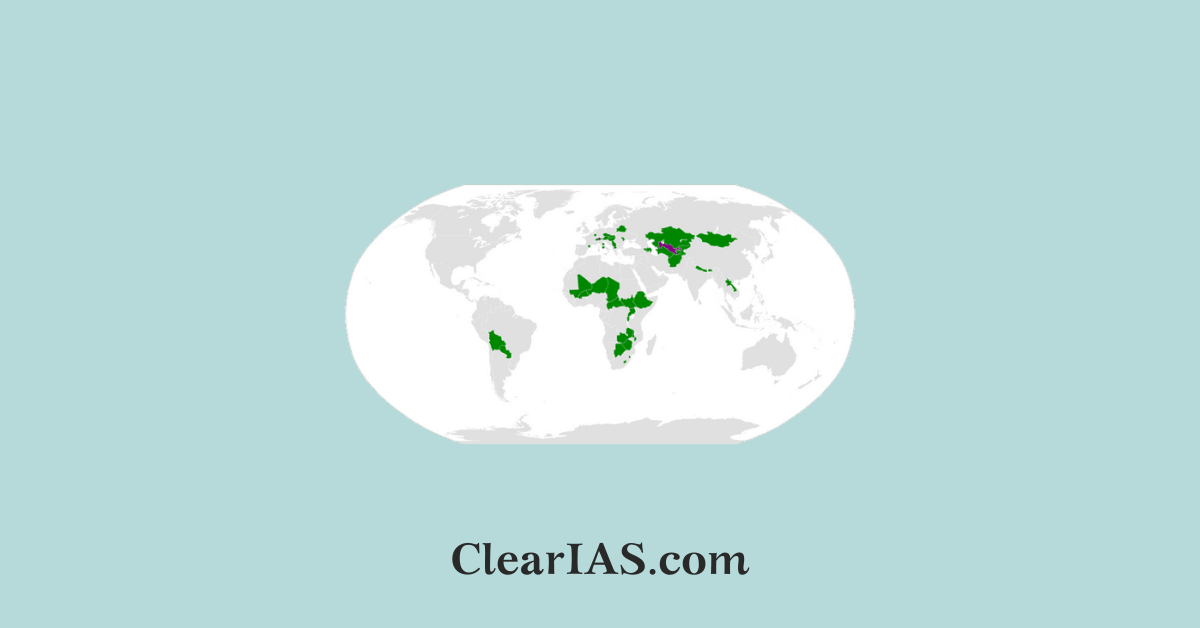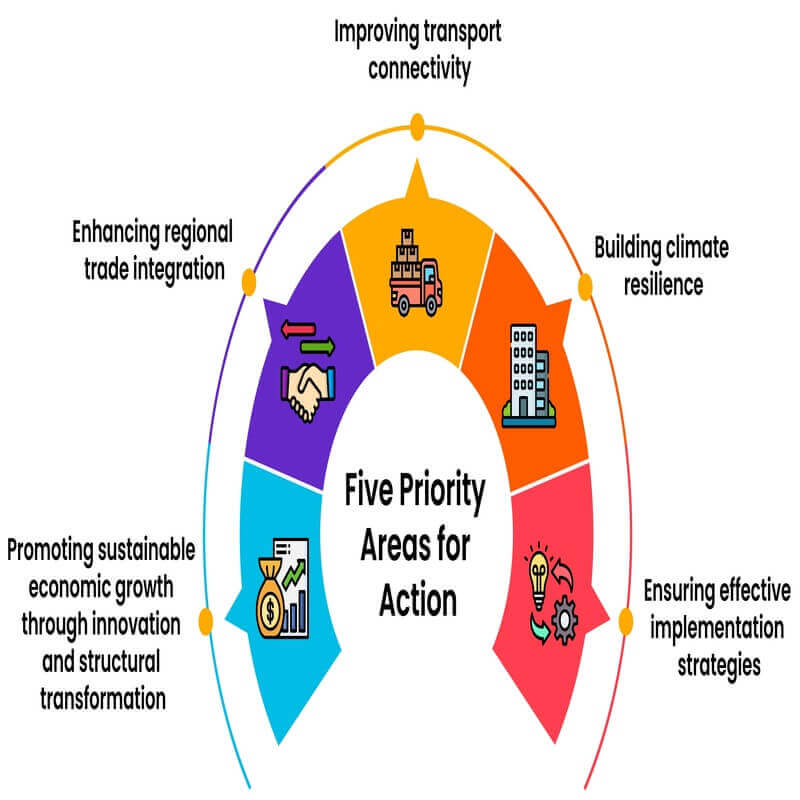
The UN General Assembly has adopted the Programme of Action for Landlocked Developing Countries (LLDCs), 2024–2034. It builds on the Vienna Programme of Action (2014-2024) & Almaty Programme of Action (2003), which laid the groundwork for addressing challenges faced by Landlocked Developing Countries (LLDCs). Read here to learn more.
The UN General Assembly has adopted a new Programme of Action for Landlocked Developing Countries (LLDCs) for 2024–2034.
The program aims to address the unique challenges faced by these 32 countries globally, which lack direct access to the sea and rely on transit nations for international trade.
What are Landlocked Developing Countries (LLDCs)?
Landlocked Developing Countries (LLDCs) lack sea access, making them dependent on neighbouring countries for trade and access to global markets.
This geographical constraint creates economic and developmental challenges, such as higher transportation costs, limited trade competitiveness, and difficulty integrating into global value chains.
There are 32 LLDCs worldwide, mainly located in Africa, Asia, South America and Europe. Of these, 17 are Landlocked Least Developed Countries.
Africa
- Botswana
- Burkina Faso
- Burundi
- Central African Republic
- Chad
- Eswatini
- Ethiopia
- Lesotho
- Malawi
- Mali
- Niger
- Rwanda
- South Sudan
- Uganda
- Zambia
- Zimbabwe
Asia
- Afghanistan
- Armenia
- Azerbaijan
- Bhutan
- Kazakhstan
- Kyrgyzstan
- Lao PDR
- Mongolia
- Nepal
- Tajikistan
- Turkmenistan
- Uzbekistan
Latin America
- Plurinational State of Bolivia
- Paraguay
Europe
- North Macedonia
- Republic of Moldova
Landlocked Developing Countries (LLDCs) vs. Landlocked Developed Countries (LDCs)
Austria, Hungary and Slovakia as landlocked countries do not face the same trade, transport and infrastructure constraints as their developing counterparts.
LLDCs |
LDCs |
|
Geographic and Economic Context |
Located predominantly in Africa, Asia, and Latin America, they face significant geographical challenges like dependence on transit through neighbouring countries and poor infrastructure. |
European countries like Austria, Hungary, and Slovakia benefit from high connectivity, modern infrastructure, and economic integration, such as EU membership. |
Infrastructure and Connectivity |
|
Have well-developed road, rail, and port networks, ensuring efficient movement of goods and services. |
Trade and Economic Activities |
|
|
Economic Integration and Policy Support |
|
|
Cost of Doing Business |
The cost of trade is significantly higher due to:
|
Lower costs due to efficient trade systems, reduced transit times, and advanced digitalization. |
Programme of Action for Landlocked Developing Countries (LLDCs)

- Focus Areas
- Economic Diversification and Resilience: Support LLDCs in building diversified and resilient economies to reduce dependency on primary commodities.
- Infrastructure Development: Prioritize investments in transportation, energy, and digital infrastructure to improve connectivity and economic integration.
- Trade Facilitation: Enhance trade facilitation mechanisms to reduce delays, costs, and inefficiencies in cross-border trade.
- Sustainable Development Goals (SDGs): Align with the 2030 Agenda for Sustainable Development, focusing on poverty eradication, gender equality, climate resilience, and environmental sustainability.
- Transit Cooperation: Strengthen partnerships between LLDCs and transit countries to improve transit policies, reduce tariffs, and streamline customs procedures.
- Capacity Building and Technology Transfer: Support LLDCs in acquiring skills and technology to enhance industrialization, innovation, and digitalization.
- Climate Action and Disaster Resilience: Assist LLDCs in mitigating the impacts of climate change, improving disaster resilience, and transitioning to renewable energy.
- Financing for Development: Mobilize resources from multilateral development banks, private sector partnerships, and innovative financing mechanisms.
The Vienna Programme of Action
Thirty-two of the world’s landlocked developing countries face an array of challenges mainly associated with their lack of direct territorial access to the sea and remoteness from world markets.
Their dependence on other countries for international trade and transit compounds other challenges that landlocked developing countries (LLDCs) face.
The Vienna Programme of Action is centred upon addressing the challenges faced by LLDCs and aims to contribute to the eradication of poverty stemming from their landlockedness through the implementation of specific actions related to the following priority areas:
- Priority 1: Fundamental transit policy issues
- Priority 2: Infrastructure development and maintenance
(a) Transport infrastructure
(b) Energy and information and communications technology infrastructure
- Priority 3: International trade and trade facilitation
(a) International trade
(b)Trade facilitation
- Priority 4: Regional integration and cooperation
- Priority 5: Structural economic transformation
- Priority 6: Means of implementation
Challenges Faced by LLDCs
- High Trade and Transportation Costs: LLDCs pay over twice the transport costs of their coastal neighbours due to reliance on transit countries for access to international markets.
- Longer transit times, customs delays, and logistical challenges further inflate costs.
- Dependence on Transit Countries: LLDCs rely on their neighbours for access to ports, which makes them vulnerable to political instability, poor infrastructure, and economic inefficiencies in transit countries.
- Limited Foreign Direct Investment (FDI): High transport costs and logistical challenges deter foreign investors, reducing opportunities for economic diversification and development.
- Restricted Export Opportunities: LLDCs struggle to compete in global markets due to higher costs and delays, limiting their ability to export goods effectively.
- Isolation from Global Markets: Geographic remoteness hinders integration into global supply chains and reduces participation in international trade.
- Weak Regional Trade: Many LLDCs border other developing nations that face similar challenges, resulting in limited trade opportunities within the region.
- Economic Growth Constraints: The combined impact of these challenges slows economic growth, exacerbating poverty and reducing access to resources for sustainable development.
Significance of the Programme
- Enhanced Global Cooperation: The program emphasizes partnerships between LLDCs, transit countries, international organizations, and development partners.
- Economic Empowerment: By focusing on infrastructure and trade facilitation, LLDCs can enhance their economic competitiveness.
- Sustainability Focus: The program aligns with global climate goals, ensuring a sustainable development trajectory for LLDCs.
- Improved Livelihoods: Investments in infrastructure, technology, and capacity building will contribute to poverty alleviation and better living standards.
Conclusion
The adoption of this program underscores the international community’s commitment to ensuring inclusive and equitable development for LLDCs, enabling them to overcome their geographical disadvantages and actively participate in the global economy.
Frequently Asked Questions (FAQs)
Q. How many landlocked developing countries are there?
Ans: The landlocked developing countries (LLDCs) group includes 32 countries.
Q. What is the largest landlocked country?
Ans: Kazakhstan is the world’s largest landlocked country by land area and the ninth largest country in the world; its territory of 1,053,000 sq mi is larger than Western Europe. It is neighbored by Russia, China, Kyrgyzstan, Uzbekistan, and Turkmenistan, and also borders a large part of the Caspian Sea.
Related articles:
-Article by Swathi Satish






Leave a Reply